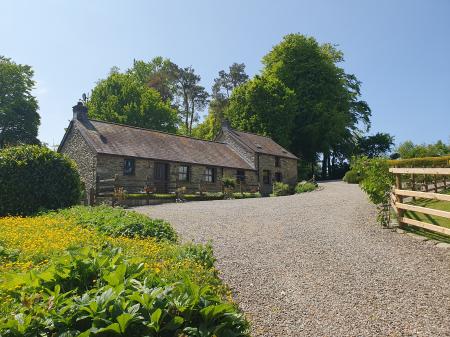
History
The fort was established during the Flavian invasion of Wales, around AD 75. The site is in a strategically important position overlooking the River Ithon. It is fairly typical of Flavian forts, enclosing a rectangle about 210 metres long and 155 metres wide, oriented on a north west to south east axis.
The fort was later reduced in size to 160 x 114 metres and the original western rampart was slighted to make it unusable.
The original defences were timber posts atop a turf wall defended by a ditch, but these defences were later rebuilt in stone. Outside the south east corner of the fort is a bath house complex that was in use until the 3rd century.
At the end of the 2nd century, semi-circular towers were built to defend gateways in the south, east, and north walls. Inside the fort the major buildings were made of stone, while the barracks were timber.
Recent investigation has unearthed a vicus, or civilian settlement, outside the walls, in what is now a wooded area to the east of the fort.
An archaeological dig in 2011 found enough Roman brick and tile fragments to suggest that there was a manufacturing centre nearby. Pottery sherds, pieces of iron objects, and a silver coin were also discovered.
Castell Collen was occupied continuously until the 3rd century. It seems to have been abandoned around AD 230 until AD 300, then reoccupied for another 3 decades until it was finally abandoned for good around AD 330.
The fort was known to 18th-century antiquarians but it was first rigorously excavated in 1911, then again in 1954. Among the objects discovered during excavations were a bronze bell, scabbard decorations, a silver ring, and a bronze brooch. Pottery from the site included castor ware cups and a cremation urn.
The Dedication Stone
One of the most interesting finds is a fragment of carved stone decorated with the likeness of a griffin. The stone is inscribed 'VE [EXLLIATIO] [LEG II] [AUG F]' which roughly translates as 'A 'Flag Section' of the Second Augustan Legion made [this fort].' The stone was found in the wall of the principia, or headquarters building in the centre of the fort.
The stone and the other objects are on display at the Radnorshire Museum in Llandrindod Wells.
Other carved stones found on the site or nearby include one discovered set into a field wall in 1926. It bears the inscription 'MARCI • F • P XXXXVI' which translates as 'The century of Marcus has made forty-six paces [of rampart].'
Another stone was found re-used in the church at Llanbadarn Fawr. It is carved with the words 'VAL FLAVINI', or '[Made by] the century of Flavius Flavinus'. Clearly the Roman soldiers who worked to build the fort wanted their efforts to be remembered.
Getting There
The fort is in a loop of the River Ithon opposite Llandrindod Wells. Access is at the end of a minor road off the A4081 between the town and Llanyre to the west. Turn right towards Castle Collen farm immediately after you cross over the river Irthon.
Follow the road to the end, where it terminates at the farm. I did find a very small sign and map on a gate at the bottom end of the farm field, but there are no information panels or any signs at the farm itself.
Ask politely at the farm if you can see the fort, which lies just beyond the farmyard! The site is clearly marked on Ordnance Survey maps. I found an OS map essential to really get a sense of where the Roman earthworks lay amid the later farm fields.
 We've 'tagged' this attraction information to help you find related historic attractions and learn more about major time periods mentioned.
We've 'tagged' this attraction information to help you find related historic attractions and learn more about major time periods mentioned.




